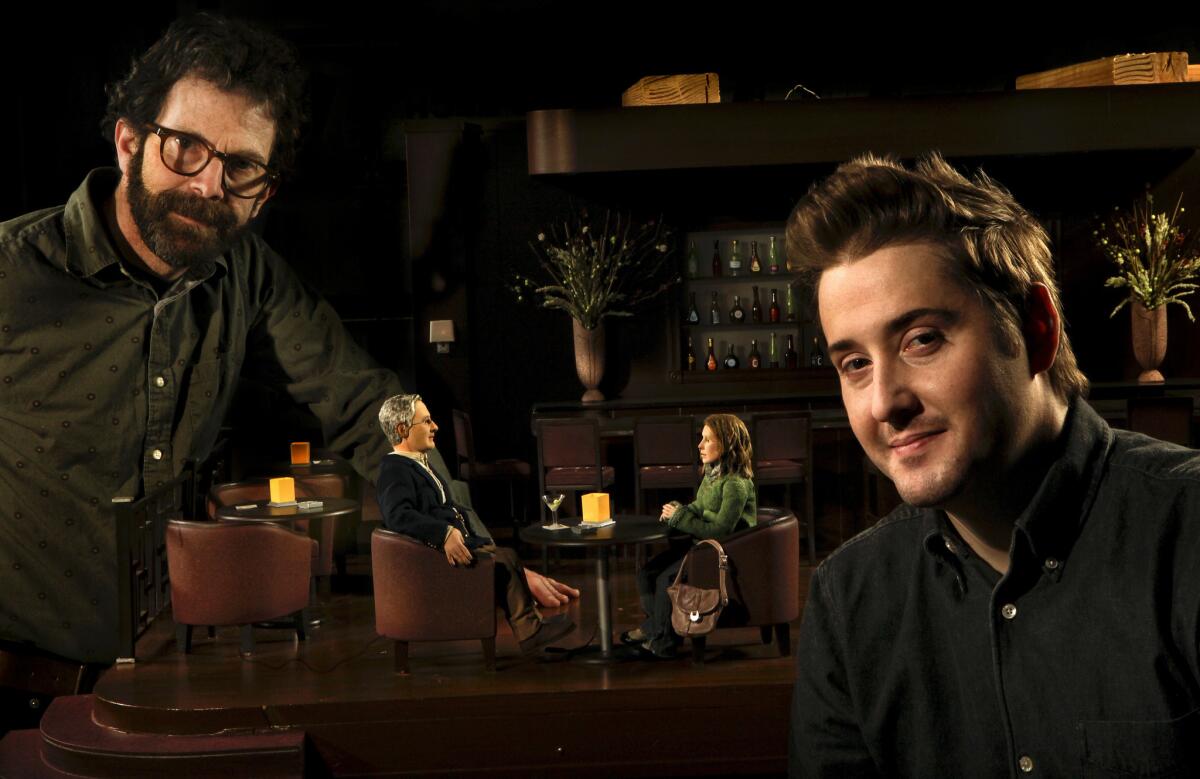How Charlie Kaufman’s ‘Anomalisa’ blossomed into a darkly original animation

Charlie Kaufman, left, and Duke Johnson, with one of the miniature movie sets they created for their stop-motion R-rated film “Anomalisa.”
Inside Starburns Industries, a castle-shaped warehouse on Isabel Street in Burbank, Charlie Kaufman and Duke Johnson were peering over a miniature movie set at their star, a distinguished, melancholy-looking puppet named Michael.
“It makes me sad, because he doesn’t really exist,” Kaufman said, stuffing his hands into his pockets as Johnson carried over a set of Michael’s tiny martini glasses, each with a twist of lemon in it smaller than a fingernail.
Kaufman and Johnson created the dollhouse-sized world together in this 30,000-square-foot warehouse, using the hundred-year-old tools of stop-motion animation to make one of the most original and adult movies of the year. Written by Kaufman and co-directed by Kaufman and Johnson, “Anomalisa” is an R-rated comedy about loneliness, with swearing, graphic sex and the drinking of many tiny martinis.
See more of Entertainment’s top stories on Facebook >>
Paramount Pictures, which bought “Anomalisa” after it collected rave reviews at the fall film festivals, will release the movie on Wednesday. The studio is mounting a robust awards campaign that has already yielded a Golden Globe nomination for animation and four Independent Spirit nominations, including best feature and screenplay.
It’s an unlikely Hollywood ending for a movie with truly handmade beginnings — a play Kaufman wrote on a whim, a Kickstarter campaign Johnson launched on a prayer, and touch-and-go financing that forced “Anomalisa’s” producer to send Cuban pastries as payment for borrowed camera rigs.
“Anomalisa’s” creators are temperamental opposites — Kaufman, the 57-year-old New York-born writer of inventive, surrealist movies like “Being John Malkovich” and “Eternal Sunshine of the Spotless Mind,” is shy, with a dry sense of humor. Johnson, the 37-year-old St. Louis-born animator best known for directing a stop-motion episode of the NBC show “Community” and the Cartoon Network series “Mary Shelley’s Frankenhole,” is boisterous and constantly moving.
“Duke would like to show you his fish,” Kaufman deadpanned when Johnson walked up on a conversation about human isolation while holding a tiny plastic object from the puppet lab.
What unites Kaufman and Johnson is that ineffable quality upon which so many creative friendships are forged — their taste. Both men like pop culture with intricately created visual worlds and a dark sense of humor: the films of Stanley Kubrick, Joel and Ethan Coen’s 1940s-set satire “Barton Fink” and the British sci-fi TV show “Black Mirror,” to name a few. They both carry small notebooks in their pockets for ideas; Kaufman’s is filled with nearly illegible scrawl about things that amuse him, like the name of a street in Queens (Dutch Kills), while Johnson’s is filled with fastidiously neat prose.
See the most-read stories in Entertainment this hour >>
“They’re a perfect pair,” said “Anomalisa” producer Rose Tran. “Charlie is an amazing writer, and Duke is super creative but also technical and understands what needs to be done.”
The Envelope Animation Roundtable


The Envelope Animation Roundtable

The Envelope Animation Roundtable | Steve Martino on keeping the 'Peanuts' legacy alive

The Envelope Animation Roundtable | Richard Starzak on creating a feature length 'Shaun the Sheep' story

The Envelope Animation Roundtable | Directors discuss casting their voice actors

The Envelope Animation Roundtable | Duke Johnson on choosing animation for 'Anomalisa'

The Envelope Animation Roundtable | Directors discuss career advice
Getting into motion
Kaufman first wrote “Anomalisa” in 2005 under a pen name for a production at UCLA’s Royce Hall. David Thewlis, Jennifer Jason Leigh and Tom Noonan, who reprise their roles as voice actors in “Anomalisa” the film, read the play onstage for “Theater of the New Ear,” an unusual event dreamed up by composer Carter Burwell, who wrote the scores for “Being John Malkovich” and “Adaptation.”
In the play and the film, the story centers on Michael Stone (Thewlis), a depressed, middle-aged author of books on customer service who struggles to connect with other people. While on a business trip, Michael meets a woman, Lisa (Leigh), who feels somehow different from every other person he meets and shakes up his lonely worldview.
Dino Stamatopoulos, an executive producer at Starburns Industries, proposed the idea of his small animation studio taking on Kaufman’s script, which the writer assumed would never get off the ground. Johnson and the Starburns team launched a Kickstarter campaign in 2012 with a video of a puppet in a bow tie telling audiences they wanted to make a Charlie Kaufman movie free of “big-studio interference.” Kickstarter raised $440,237 from 5,770 backers and caught the attention of British independent film producer Keith Calder, whose Snoot Entertainment picked up the rest of what would ultimately be an $8-million budget.
It was a small sum for a stop-motion animated feature — Oregon-based Laika Studio’s films are closer to $60 million — and forced Tran to get creative, including finding sofas in Burbank for visiting European animators to sleep on and borrowing expensive equipment from vendors who had a soft spot for the old-fashioned form.
Unlike most stop-motion, which is set in fantastical realms, such as the films of Laika and English studio Aardman Animations, “Anomalisa” re-creates the most mundane of life events, a business trip. The forlorn black roller bag, the overly talkative cabby, the moment of sinking alone onto a crisply made hotel bed — it’s a world that will likely feel specific and familiar to anyone who has ever ordered room service for one. The movie’s protagonist is staying at the Fregoli Hotel, a reference to a psychological disorder in which a person holds a delusional belief that different people are a single person. (Kaufman also wrote the play under the pseudonym Francis Fregoli.)
Through a narrative device best enjoyed without the audience knowing too much in advance, the filmmakers make a virtue of one of stop-motion’s quirks, that puppet faces produced on 3-D printers are split into two plates, with seams dividing them above the jawline. Normally stop-motion studios work to conceal those seams, but in “Anomalisa” they are visible and take on a significance relevant to the story’s thematic concerns — what it means to be human and to find a connection with another person.
“The unique thing about stop-motion is that it feels organic,” Johnson said. “You can feel the human hands in this inorganic doll, which can be creepy, and it can be beautiful.”
Tender puppetry
Among its many unique qualities, the movie contains a tender sex scene between two anatomically correct puppets, which somehow feels more human than the countless live-action love scenes staged between perfect, beautiful human beings that Hollywood produces each year.
“We didn’t want to betray the characters by making a joke out of it,” Kaufman said of the much discussed puppet sex.
“Anomalisa” is Kaufman’s first film in six years since his critically acclaimed but commercially disappointing directorial debut, “Synecdoche, New York.” At work on another original script for Paramount, he writes every day, mostly in his home in Pasadena, where he lives with his wife and two children.
Johnson, who is single and collects oddities like shrunken heads, is planning to direct a live-action film next.
The team behind “Anomalisa” seems stunned by its overwhelmingly positive reception, perhaps no one more so than Kaufman, who is impervious to compliments. Quiet through much of a reporter’s tour of the sets at Starburns, he finally piped up about a powerful detail in the film that had been missed, a crack on the side of an ornate sex doll Michael buys.
“Yeah, nobody else got it either,” Kaufman said, with a shrug. He said he liked the creative control he had working in the stop-motion medium, where each gesture is so precisely calibrated that animators had a goal of completing just two seconds, or 48 frames, of animation per day.
“There’s something fragile and human about it,” Kaufman said. “You know humans made it, because it’s imperfect.”
Twitter: @ThatRebecca
More to Read
Only good movies
Get the Indie Focus newsletter, Mark Olsen's weekly guide to the world of cinema.
You may occasionally receive promotional content from the Los Angeles Times.











